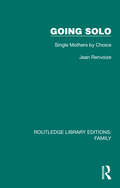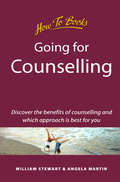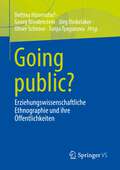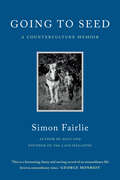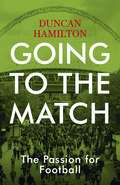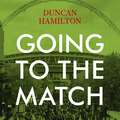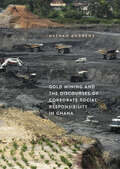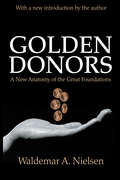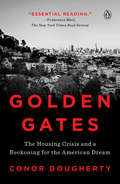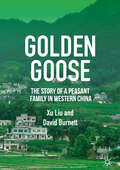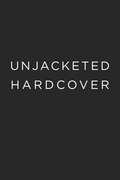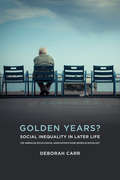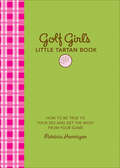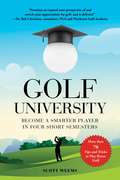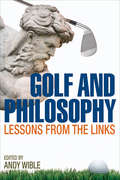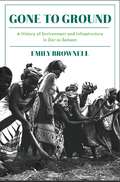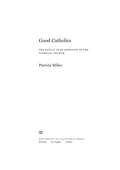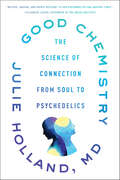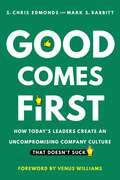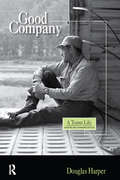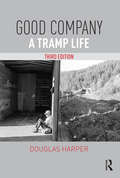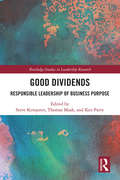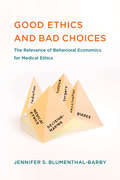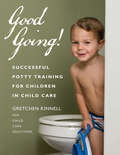- Table View
- List View
Going Solo: Single Mothers by Choice (Routledge Library Editions: Family)
by Jean RenvoizeOriginally published in 1985, this, at the time, controversial book explores the fundamental changes in personal relationships that had taken place over the previous decade, focusing on women who had deliberately chosen to have children outside a permanent relationship. After travelling widely throughout Britain, the United States and Holland meeting those personally involved, Jean Renvoize discusses why a growing number of women were deciding to become single mothers. She discovers the implications of this for the future of the family and for old-style love and commitment between the sexes. She analyses the position both of the children of these single families and of their mothers. She looks at men’s feelings about being used a ‘stud’ and uncovers the desire of some men to have a family without being financially and emotionally involved with a long-term partner. Importantly, Jean Renvoize places the new style of personal relationship in the context of the advance of the women’s movement. It is clear that ordinary and non-political women’s and men’s lives have been more fundamentally changed by feminism than they may realise. But few of the mothers interviewed by the author are actively feminist: lesbians apart, they all have in common past relationships with men, and would happily settle with the right man could their high expectations be met. Without exception, all those who made the deliberate choice to ‘go solo’ have loving, joyful and rewarding experiences of motherhood. Having a child alone has been fraught with problems for all, but those who have met the challenge have found such great fulfilment that one is faced with an inevitable question: are a woman and her child better off without a man? When so many marriages end in divorce, is a stable unit of two better than a broken unit of three? But also, might those without the motivation of successful ‘solo mothers’ rush thoughtlessly into motherhood – and find themselves exhausted, broke and very unhappy? Presenting in their own words the experiences of those directly involved, this was above all a practical book. It provided welcome and necessary insights into the changing pattern of relationships at the time – for the married and unmarried; for parents and non-parents. Today it can be read and enjoyed in its historical context.
Going for Counselling: Working with your counsellor to develop awareness and essential life skills
by William StewartThis book explores the counselling process and will help you to choose a counsellor to suit your needs. Counselling isn't always problem centred. It can enable you to develop self-awareness and introduce you to ways in which you can manage your life more effectively. This book will show you how.
Going public?: Erziehungswissenschaftliche Ethnographie und ihre Öffentlichkeiten
by Georg Breidenstein Tanya Tyagunova Jörg Dinkelaker Bettina Hünersdorf Oliver SchnoorDer Band dokumentiert die facettenreiche Diskussion des Verhältnisses von erziehungswissenschaftlicher Ethnographie zu ihren Öffentlichkeiten in gegenstandstheoretischer, methodologischer und politischer Hinsicht. Die Beiträge befassen sich mit der Frage, ob und warum sich erziehungswissenschaftliche Ethnographie welche Öffentlichkeiten erschließt bzw. erschließen sollte und welche Effekte jeweils davon für diese bzw. für (sozial-)pädagogische Handlungsfelder und ihre Adressat*innen ausgehen.
Going to Seed: A Counterculture Memoir
by Simon FairlieAn unforgettable firsthand account of how the hippie movement flowered in the late 1960s, appeared spent by the Thatcher-consumed 1980s, yet became the seedbed for progressive reform we now take for granted—and continues to inspire generations of rebels and visionaries. "Fairlie has a refreshingly declarative style: he’s analytical, funny and self-aware. . . His memoir has much to offer anyone interested in movement history or in the future of intentional communities."—Elizabeth Royte, Food & Environment Reporting Network At a young age, Simon Fairlie rejected the rat race and embarked on a new trip to find his own path. He dropped out of Cambridge University to hitchhike to Istanbul and bicycle through India. He established a commune in France, was arrested multiple times for squatting and civil disobedience, and became a leading figure in protests against the British government’s road building programs of the 1980s and—later—in legislative battles to help people secure access to land for low impact, sustainable living. Over the course of fifty years, we witness a man’s drive for self-sufficiency, freedom, authenticity, and a deep connection to the land. Fairlie grew up in a middle-class household in leafy middle England. His path had been laid out for him by his father: boarding school, Oxbridge, and a career in journalism. But everything changed when Simon’s life ran headfirst into London’s counterculture in the 1960s. Finding Beat poetry, blues music, cannabis and anti–Vietnam War protests unlocked a powerful lust to be free. Instead of becoming a celebrated Fleet Street journalist like his father, Simon became a laborer, a stonemason, a farmer, a scythesman, and then a magazine editor and a writer of a very different sort. In Going to Seed he shares the highs of his experience, alongside the painful costs of his ongoing search for freedom—estrangement from his family, financial insecurity, and the loss of friends and lovers to the excesses and turbulence that continued through the 70s and 80s. Part moving, free-wheeling memoir, part social critique, Going to Seed questions the current trajectory of Western “progress”—and the explosive consumerism, growing inequality, and environmental devastation laid bare in our daily newsfeeds—and will resonate with anyone who wonders how we got to such a place. Simon’s story is for anyone who wonders what the world might look like if we began to chart a radically different course.
Going to the Match: The Passion for Football
by Duncan HamiltonA massive audience in sitting-rooms, parks and pubs watched England in the 2018 World Cup. Yet as Duncan Hamilton demonstrates with style, insight and wit in Going to the Match, watching on TV is no substitute for being there. Hamilton embarks on a richly entertaining, exquisitely crafted journey through football. Glory game or grass roots, England v Slovenia or Guiseley v Hartlepool, he delves beneath the action to illuminate the stories which make the sport endlessly compelling.Along the way he marvels at present-day titans Harry Kane, Mo Salah, Kevin De Bruyne and Paul Pogba, reflects on sepia-tinted magicians Stanley Matthews, Jimmy Greaves, Bobby Charlton and Pele, and assesses managerial giants from Brian Clough and Jose Mourinho to Arsene Wenger and Gareth Southgate.The odyssey takes Hamilton from Fleetwood to Berlin, via Glasgow and a Manchester derby, making detours into art, cinema, literature and politics as he explores the game's ever-changing culture and character.The result, like the L.S. Lowry painting that inspired the book, is a football masterpiece.
Going to the Match: The Perfect Gift for Football Fans
by Duncan HamiltonA massive audience in sitting-rooms, parks and pubs watched England in the 2018 World Cup. Yet as Duncan Hamilton demonstrates with style, insight and wit in Going to the Match, watching on TV is no substitute for being there. Hamilton embarks on a richly entertaining, exquisitely crafted journey through football. Glory game or grass roots, England v Slovenia or Guiseley v Hartlepool, he delves beneath the action to illuminate the stories which make the sport endlessly compelling.Along the way he marvels at present-day titans Harry Kane, Mo Salah, Kevin De Bruyne and Paul Pogba, reflects on sepia-tinted magicians Stanley Matthews, Jimmy Greaves, Bobby Charlton and Pele, and assesses managerial giants from Brian Clough and Jose Mourinho to Arsene Wenger and Gareth Southgate.The odyssey takes Hamilton from Fleetwood to Berlin, via Glasgow and a Manchester derby, making detours into art, cinema, literature and politics as he explores the game's ever-changing culture and character.The result, like the L.S. Lowry painting that inspired the book, is a football masterpiece.
Going to the Match: The Perfect Gift for Football Fans
by Duncan HamiltonA celebration of football by award-winning sports writer, Duncan Hamilton.A massive audience in sitting-rooms, parks and pubs watched England in the 2018 World Cup. Yet as Duncan Hamilton demonstrates with style, insight and wit in Going to the Match, watching on TV is no substitute for being there. Hamilton embarks on a richly entertaining, exquisitely crafted journey through football. Glory game or grass roots, England v Slovenia or Guiseley v Hartlepool, he delves beneath the action to illuminate the stories which make the sport endlessly compelling.Along the way he marvels at present-day titans Harry Kane, Mo Salah, Kevin De Bruyne and Paul Pogba, reflects on sepia-tinted magicians Stanley Matthews, Jimmy Greaves, Bobby Charlton and Pele, and assesses managerial giants from Brian Clough and Jose Mourinho to Arsene Wenger and Gareth Southgate.The odyssey takes Hamilton from Fleetwood to Berlin, via Glasgow and a Manchester derby, making detours into art, cinema, literature and politics as he explores the game's ever-changing culture and character.The result, like the L.S. Lowry painting that inspired the book, is a football masterpiece.(P)2018 Hodder & Stoughton Limited
Gold Mining and the Discourses of Corporate Social Responsibility in Ghana
by Nathan AndrewsThis book critically examines the practice and meanings of corporate social responsibility (CSR) and how the movement has facilitated a positive and somewhat unquestioned image of the global corporation. Drawing on extensive fieldwork material collected in Ghanaian communities located around the project sites of Newmont Mining Corporation and Kinross Gold Corporation, the monograph employs critical discourse analysis to accentuate how mining corporations use CSR as a discursive alibi to gain legitimacy and dominance over the social order, while determining their own spheres of responsibility and accountability. Hiding behind such notions as ‘social licence to operate’ and ‘best practice,’ corporations are enacted as entities that are morally conscious and socially responsible. Yet, this enactment is contested in host communities, as explored in chapters that examine corporate citizenship, gendered perspectives, and how global CSR norms institutionalize unaccountability.
Golden Donors: A New Anatomy of the Great Foundations
by Waldemar A. NielsenThe world of the golden donors - the rich and influential philanthropic foundations - is quite likely the least known and yet most pervasive of all the invisible money and power networks in America. Nielsen explores the 36 largest of the 22,000 currently active foundations. He takes the reader inside each of the giants to analyze its people, policies, and performance. From the most famous, Ford and MacArthur, to the most obscure, Mabee and Moody, the author lets in daylight and lets out the bats as well as the butterflies. Golden Donors is a journey through 36 flefdoms, each of which controls upwards of $250 million dollars, beyond the reach of the IRS, in order to encourage medical research, support cultural and artistic endeavors, and not least, to buttress immensely expensive educational institutions. Which of the great foundations in recent years have been spectacular successes and which are failures? Is today's leadership in the third-stream economy equal to the task? Are foundations, seedbeds or killing grounds of new social and political ideas? And what is the federal government, and a variety of administrations, doing to help or harm this new economy? Nielsen provides many surprising and some quite startling answers for the millions of Americans whose lives the golden donors directly or indirectly affect. When Golden Donors first appeared, A. Bartlett Giamatti praised it as an historical guide, a shrewd critique, and an impassioned warning. "This remarkable book on the nation's largest foundations must be ready by anyone concerned with America's unique not-for-profit sector and the quality of our national life." Kingman Brewster saw the book as "a revealing mirror held up to the faces of big philanthropy...a must book for foundation creators and leaders." Thornton F. Bradsahw said, "Golden Donors describes the large American foundations, what they are how they got that way, and wherein lies their strength and their potential. The book is wise, witty, and perceptive - indispensable reading."
Golden Gates: Fighting for Housing in America
by Conor DoughertyA stunning, deeply reported investigation into the housing crisis Spacious and affordable homes used to be the hallmark of American prosperity. Today, however, punishing rents and the increasingly prohibitive cost of ownership have turned housing into the foremost symbol of inequality and an economy gone wrong. Nowhere is this more visible than in the San Francisco Bay Area, where fleets of private buses ferry software engineers past the tarp-and-plywood shanties where the homeless make their homes. The adage that California is a glimpse of the nation's future has become a cautionary tale.With propulsive storytelling and ground-level reporting, New York Times journalist Conor Dougherty chronicles America's housing crisis from its West Coast epicenter, peeling back the decades of history and economic forces that brought us here and taking readers inside the activist uprisings that have risen in tandem with housing costs. To tell this new story of housing, Dougherty follows a struggling math teacher who builds a political movement dedicated to ending single-family-house neighborhoods. A teenaged girl who leads her apartment complex against their rent-raising landlord. A nun who tries to outmaneuver private equity investors by amassing a multimillion-dollar portfolio of affordable homes. A suburban bureaucrat who roguishly embraces density in response to the threat of climate change. A developer who manufactures homeless housing on an assembly line.Sweeping in scope and intimate in detail, Golden Gates captures a vast political realignment during a moment of rapid technological and social change.
Golden Goose: The Story of a Peasant Family in Western China
by David Burnett Xu LiuThis book offers an intimate and personal look at what China's poverty alleviation has meant for individuals. The dramatic progress in reducing poverty in China over the past three decades is well known. According to the World Bank, more than 500 million people were lifted out of extreme poverty as China’s poverty rate fell from 88 percent in 1981 to 6.5 percent in 2012. Behind this statistic are the millions of families in rural China who have moved from extreme poverty to a more comfortable way of life in modern China. This is the story of four generations of one such family. Grandma Zhen and her eight children have faced the hardship of war, the great famine of 1958-1960, the Cultural Revolution of 1967-1977 and Opening-up and Reform. They have had to adjust to a rapidly changing culture that has affected all aspects of their lives, including marriage, the one-child policy, and education. Through incredible endurance and hard work, they have not only survived, but thrived. This book will be of value to anthropologists, developmental economists, sinophiles, and more.
Golden Gulag: Prisons, Surplus, Crisis, and Opposition in Globalizing California (American Crossroads #21)
by Ruth Wilson GilmoreSince 1980, the number of people in U.S. prisons has increased more than 450%. Despite a crime rate that has been falling steadily for decades, California has led the way in this explosion, with what a state analyst called "the biggest prison building project in the history of the world." Golden Gulag provides the first detailed explanation for that buildup by looking at how political and economic forces, ranging from global to local, conjoined to produce the prison boom. In an informed and impassioned account, Ruth Wilson Gilmore examines this issue through statewide, rural, and urban perspectives to explain how the expansion developed from surpluses of finance capital, labor, land, and state capacity. Detailing crises that hit California's economy with particular ferocity, she argues that defeats of radical struggles, weakening of labor, and shifting patterns of capital investment have been key conditions for prison growth. The results--a vast and expensive prison system, a huge number of incarcerated young people of color, and the increase in punitive justice such as the "three strikes" law--pose profound and troubling questions for the future of California, the United States, and the world. Golden Gulag provides a rich context for this complex dilemma, and at the same time challenges many cherished assumptions about who benefits and who suffers from the state's commitment to prison expansion.
Golden Years?: Social Inequality in Later Life (American Sociological Association's Rose Series)
by Deborah CarrThanks to advances in technology, medicine, Social Security, and Medicare, old age for many Americans is characterized by comfortable retirement, good health, and fulfilling relationships. But there are also millions of people over 65 who struggle with poverty, chronic illness, unsafe housing, social isolation, and mistreatment by their caretakers. What accounts for these disparities among older adults? Sociologist Deborah Carr’s Golden Years? draws insights from multiple disciplines to illuminate the complex ways that socioeconomic status, race, and gender shape the nearly every aspect of older adults’ lives. By focusing on an often-invisible group of vulnerable elders, Golden Years? reveals that disadvantages accumulate across the life course and can diminish the well-being of many. Carr connects research in sociology, psychology, epidemiology, gerontology, and other fields to explore the well-being of older adults. On many indicators of physical health, such as propensity for heart disease or cancer, black seniors fare worse than whites due to lifetimes of exposure to stressors such as economic hardships and racial discrimination and diminished access to health care. In terms of mental health, Carr finds that older women are at higher risk of depression and anxiety than men, yet older men are especially vulnerable to suicide, a result of complex factors including the rigid masculinity expectations placed on this generation of men. Carr finds that older adults’ physical and mental health are also closely associated with their social networks and the neighborhoods in which they live. Even though strong relationships with spouses, families, and friends can moderate some of the health declines associated with aging, women—and especially women of color—are more likely than men to live alone and often cannot afford home health care services, a combination that can be isolating and even fatal. Finally, social inequalities affect the process of dying itself, with white and affluent seniors in a better position to convey their end-of-life preferences and use hospice or palliative care than their disadvantaged peers. Carr cautions that rising economic inequality, the lingering impact of the Great Recession, and escalating rates of obesity and opioid addiction, among other factors, may contribute to even greater disparities between the haves and the have-nots in future cohorts of older adults. She concludes that policies, such as income supplements for the poorest older adults, expanded paid family leave, and universal health care could ameliorate or even reverse some disparities. A comprehensive analysis of the causes and consequences of later-life inequalities, Golden Years? demonstrates the importance of increased awareness, strong public initiatives, and creative community-based programs in ensuring that all Americans have an opportunity to age well.
Golf Girl's Little Tartan Book: How to Be True to Your Sex and Get the Most from Your Game
by Patricia HanniganPlay like a girl! A female golf writer offers tips, inspiration, and laughs for women who want to excel at the sport. Golf blogger Patricia Hannigan has a driving ambition: to get each of her thousands of female followers to play like a girl. That, she insists, is just the way for a woman to excel at golf—and, every bit as important, to have a lot of fun doing so. A witty and wise departure from oh-so-predictable instructional guides, Golf Girl&’s Little Tartan Book doesn&’t focus only on technique. Hannigan also writes about attitude and the mental game, demonstrating how a gal who&’s passionate about golf can use her womanly style to her distinct advantage on the course. From teeing off (don&’t be coy about using those red tees) to getting teed off (don&’t be timid about throwing the occasional tantrum), Hannigan entertainingly dispenses advice that&’s sure to be useful to any woman intent on securing membership in the &“boys&’ club&” called golf.
Golf University: Become a Better Putter, Driver, and More—the Smart Way
by Scott WeemsIn Golf University, Scott Weems offers comprehensive advice to excelling on the golf course that takes readers beyond traditional tips on putting and driving. Divided into four “semesters,” this book incorporates the disciplines of physics, math, medicine, sociology, geology, economics, and more to help golfers maximize their success and have the most fun. Some of the many lessons that Weems offers include: Achieving maximum efficiency in the golf swing, meaning no loss of kinetic energy from club to ball, would require a driver 72 feet long. And a club the same weight as the ball. Twelve percent of business executives rate golf as more important than sex. Players shot half a stroke higher when paired with Tiger Woods in his prime. The effect was even worse on the final day of competition. Putting against the direction of the grain (i.e., opposite the most recent mowing) leaves the ball 15 percent shorter than putting in the opposite direction. Closing your eyes occasionally while putting will leave your ball almost 10 percent closer to the pin. And more! Golf University uses a mixture of research, interviews, and Weems’s own experiences as a scientist and golfer to introduce readers to the latest discoveries in the sport.
Golf and Philosophy: Lessons from the Links (The Philosophy of Popular Culture)
by Andy WibleReflections on the game and getting through life&’s hazards and roughs. In a game where players are expected to call their own penalties and scoring the least points leads to victory, decorum takes precedence over showmanship and philosophical questions become par for the course. Few other sports are as suited for ethical and metaphysical examination as golf. It is a game defined by dichotomies—relaxing, yet frustrating, social, yet solitary—and between these extremes there is room for much philosophical inquiry. In Golf and Philosophy: Lessons from the Links, a clubhouse full of skilled contributors tee off on a range of philosophical topics within the framework of the fairway. The book&’s chapters are arranged in the style of an eighteen-hole golf course, with the front nine exploring ethical matters of rationality and social civility in a world of moral hazards and roughs. The back nine pries even deeper, slicing into matters of the metaphysical, including chapters on mysticism, idealism, identity, and meaning. Taken together, the collection examines the intellectual nature of this beloved pastime, considering the many nuances of a sport that requires high levels of concentration, patience, and consistency, as well as upstanding character. Golf and Philosophy celebrates the joys and complexities of the game, demonstrating that golf has much to teach both its spectators and participants about modern life. &“Any volume built on the premise that if Aristotle and Plato were still here they&’d likely be ardent golfers is apt to tickle a few brain cells.&” ―Golf Magazine
Gone to Ground: A History Of Environment And Infrastructure In Dar Es Salaam
by Emily BrownellGone to Ground is an investigation into the material and political forces that transformed the cityscape of Dar es Salaam, Tanzania in the 1970s and early 1980s. It is both the story of a particular city and the history of a global moment of massive urban transformation from the perspective of those at the center of this shift. Built around an archive of newspapers, oral history interviews, planning documents, and a broad compendium of development reports, Emily Brownell writes about how urbanites navigated the state’s anti-urban planning policies along with the city’s fracturing infrastructures and profound shortages of staple goods to shape Dar’s environment. They did so most frequently by “going to ground” in the urban periphery, orienting their lives to the city’s outskirts where they could plant small farms, find building materials, produce charcoal, and escape the state’s policing of urban space. Taking seriously as historical subject the daily hurdles of families to find housing, food, transportation, and space in the city, these quotidian concerns are drawn into conversation with broader national and transnational anxieties about the oil crisis, resource shortages, infrastructure, and African socialism. In bringing these concerns together into the same frame*, Gone to Ground* considers how the material and political anxieties of the era were made manifest in debates about building materials, imported technologies, urban agriculture, energy use, and who defines living and laboring in the city.
Good Catholics
by Patricia MillerGood Catholics tells the story of the remarkable individuals who have engaged in a nearly fifty-year struggle to assert the moral legitimacy of a pro-choice position in the Catholic Church, as well as the concurrent efforts of the Catholic hierarchy to suppress abortion dissent and to translate Catholic doctrine on sexuality into law. Miller recounts a dramatic but largely untold history of protest and persecution, which demonstrates the profound and surprising influence that the conflict over abortion in the Catholic Church has had not only on the church but also on the very fabric of U.S. politics. Good Catholics addresses many of today's hot-button questions about the separation of church and state, including what concessions society should make in public policy to matters of religious doctrine, such as the Catholic ban on contraception.
Good Chemistry: The Science of Connection, from Soul to Psychedelics
by Julie HollandA psychiatrist and psychedelic researcher explores the science of connection—why we need it, how we’ve lost it, and how we might find it again.We are suffering from an epidemic of disconnection that antidepressants and social media can’t fix. This state of isolation puts us in “fight or flight mode,” deranging sleep, metabolism and libido. What’s worse, we’re paranoid of others. This kill-or-be-killed framework is not a way to live. But, when we feel safe and loved, we can rest, digest, and repair. We can heal. And it is only in this state of belonging that we can open up to connection with others.In this powerful book, Holland helps us to understand the science of connection as revealed in human experiences from the spiritual to the psychedelic. The key is oxytocin—a neurotransmitter and hormone produced in our bodies that allows us to trust and bond. It fosters attachment between mothers and infants, romantic partners, friends, and even with our pets. There are many ways to reach this state of mental and physical wellbeing that modern medicine has overlooked. The implications for our happiness and health are profound. We can find oneness in meditation, in community, or in awe at the beauty around us. Another option: psychedelic medicines that can catalyze a connection with the self, with nature, or the cosmos. Good Chemistry points us on the right path to forging true and deeper attachments with our own souls, to one another, and even to our planet, helping us heal ourselves and our world.
Good Comes First: How Today's Leaders Create an Uncompromising Company Culture That Doesn't Suck
by S. Chris Edmonds Mark S. BabbittDiscover the practical, step-by-step guide to creating a workplace culture that&’s better for employees, customers, and stakeholders—and your company&’s bottom line. For decades, talented people have tolerated old-school leaders who put results before respect, toxic company cultures, and workplaces that suck. But those days are over, and if leaders want to attract and retain the best employees—while improving productivity, customer service, employee satisfaction, and profits—it&’s time for them to create work cultures where good comes first. The problem is that because the corporate world has too often been driven primarily by results, we seldom ask leaders to change their work cultures. Even if we did, most leaders don&’t know how. This book provides the actionable inspiration and practical direction needed to make that change happen. In Good Comes First, S. Chris Edmonds and Mark S. Babbitt go beyond theoretical advice, using their combined 50 years of experience to present proven strategies for creating purposeful, positive and productive work cultures. Cultures where good comes first for employees, customers, leaders, and stakeholders—and where improved business outcomes quickly follow. In these pages, readers will learn to: Appreciate why a good comes first culture is a business imperative – especially for younger generations. Distance yourself from the competition that maintains its undefined work culture (one that most likely sucks). Identify what &“good&” means for your company in today&’s business climate – and in the future of work. Define your uncompromising work culture as you build a foundation of respect AND results. Formalize your team&’s servant purpose so that everyone understands how what your team does improves lives and communities. Specify respectful behaviors, so your desired values are observable, tangible, and measurable. Align your entire organization to your desired work culture – where good comes first every day. Assess the quality of your current work culture by measuring and monitoring how well your leaders and your executive team demonstrate your servant purpose, valued behaviors, strategies, and goals. Hold everyone accountable for both respect and results through modeling, celebrating, measuring, coaching, and mentoring leaders and team members. Implement real, needed change – and quit &“thinking&” and &“talking&” about change (but never really get change started). Become a change champion while creating a lasting legacy as a business leader. Build a team of good people doing good work in a good company. What&’s more, Good Comes First shows you where potential barriers to success hide—and how to push through them—and illuminates the moments when you&’ll feel the most satisfaction and gain the most traction. After reading this book, you will see that when done right, change is not only possible—it&’s practical, powerful, and profitable. And you will realize that you are the right person, at the right time, to make that change happen.
Good Company
by Douglas HarperGood Company: A Tramp Life, is a vivid portrait of a lifestyle long part of America's history, yet rapidly disappearing. The author traveled extensively by freight train to gain rich insights into the elusive world of the tramp. Richly illustrated with 85 photographs by the author, the book presents the homeless man as an individual who "drank, migrated, and worked at day labor" rather than the stereotype of a victim of alcoholism. The tramps with whom Harper shared boxcars and hobo jungles were the labor force that harvested the crops in most of the apple orchards in the Pacific Northwest. They were drawn to the harvest from across the United States and migrated primarily on freight trains, as had hobos in the 1930s. Although not without its problems, the tramp way of life is a fierce and independent culture that has been an integral part of our American identity and an important part of our agricultural economy. Since the first edition of this classic book was published by the University of Chicago Press, the tramp has virtually disappeared from the American social landscape. The agricultural labor force is now made up of Hispanic migrants. This significantly revised and updated edition contrasts this disappearing lifestyle with the homelessness of the modern era, which has been produced by different economic and sociological forces, all of which have worked against the continuation of the tramp as a social species. The new edition richly documents the transition in our society from "tramps" to urban homelessness and the many social, political, and policy changes attendant to this transformation. It also includes an additional thirty-five previously unpublished photographs from the original research.
Good Company: A Tramp Life
by Douglas HarperThis sociological classic shows how the railroad tramp’s status as a deviant changed from frontier itinerant to post settlement vagrant; from class conscious proletariat in the Depression to the damaged post WWII vet. The third edition (with new photos) discusses how today the freights have become the milieu of violent gangs who transport drugs, human traffickers, and serial killers. Beating the odds against increased post 9/11 surveillance are yuppie adventure seekers, young travelers, crust punks and oogles. In the background is the same freight train—unforgiving and lethal—and cultures policed at times by honorable tramps and at times by sadistic enforcers of violent gangs.? Features of the new edition: Eight previously unpublished photos that reflect new directions in visual ethnography. (90 photos altogether) A fuller integration of photos made during the author’s participant research with tramps over thousands of miles on the freights and while living homeless in urban America. New, nuanced edit of a narrative describing author’s five week immersion with the quintessential tramp of the era, Carl.
Good Dividends: Responsible Leadership of Business Purpose (Routledge Studies in Leadership Research)
by Ken Parry Thomas Maak Steve KempsterThis book seeks to answer the question of ‘leadership for what?’. We shall outline an answer by focusing on responsible leadership of purpose through an inter-disciplinary perspective. Responsible leadership moves the axis of leadership from leader-followers to leader-stakeholders; away from looking at leadership as person-centric – the qualities, abilities, and effectiveness of the leader, to a focus on the purposes, responsibilities and activities of leadership. Leadership orientation is about realising value for a range of constituencies, not just the shareholders of the business. In this way this book offers up an alternative business model to that of dominant neo-liberal approaches to capitalism and its flow-on effect to the leadership project. This is a model that draws on a most obvious assumption – if leaders maximise the use of all the capitals of their business they will maximise their dividends, and thus deliver their responsibility to the shareholders as well as other relevant stakeholders. This book explores how five dividends (based on five capitals) can be developed through attention to a sixth dividend (and sixth capital) – the dividend from our planet and communities. The planetary dividend is the flourishing of humanity – but it is also a significant dividend to the business. For example, by engaging the business in a purpose-led orientation to enhance the planetary dividend, the dividend from human resourcefulness becomes manifest – employee sense of purpose, commitment, passion and energy. The realisation of such can also connect with dividends from innovation, operations and brands. For example, the business benefits from a purpose-driven brand. In short, responsible leadership of purpose outlines a case for leadership to focus on a connected portfolio of ‘good’ dividends as an answer to the question ‘leadership for what?’ The book is written by academics and organisational leaders. It draws on a range of research with leaders from a variety of contexts to illustrate the challenges but also the benefits of this argument. It is an ambitious book: ambitious, in terms of moving leadership towards realising purpose; ambitious by seeking to align a range of business disciplines around responsible leadership; and ambitious because it challenges the dominant assumptions that shape business leadership. However, it is based on a simple question: why would a business not wish to generate good dividends for all its stakeholders?
Good Ethics and Bad Choices: The Relevance of Behavioral Economics for Medical Ethics (Basic Bioethics)
by Jennifer S. Blumenthal-BarbyAn analysis of how findings in behavioral economics challenge fundamental assumptions of medical ethics, integrating the latest research in both fields.Bioethicists have long argued for rational persuasion to help patients with medical decisions. But the findings of behavioral economics—popularized in Thaler and Sunstein&’s Nudge and other books—show that arguments depending on rational thinking are unlikely to be successful and even that the idea of purely rational persuasion may be a fiction. In Good Ethics and Bad Choices, Jennifer Blumenthal-Barby examines how behavioral economics challenges some of the most fundamental tenets of medical ethics. She not only integrates the latest research from both fields but also provides examples of how physicians apply concepts of behavioral economics in practice. Blumenthal-Barby analyzes ethical issues raised by &“nudging&” patient decision making and argues that the practice can improve patient decisions, prevent harm, and perhaps enhance autonomy. She then offers a more detailed ethical analysis of further questions that arise, including whether nudging amounts to manipulation, to what extent and at what point these techniques should be used, when and how their use would be wrong, and whether transparency about their use is required. She provides a snapshot of nudging &“in the weeds,&” reporting on practices she observed in clinical settings including psychiatry, pediatric critical care, and oncology. Warning that there is no &“single, simple account of the ethics of nudging,&” Blumenthal-Barby offers a qualified defense, arguing that a nudge can be justified in part by the extent to which it makes patients better off.
Good Going!
by Gretchen Kinnell for the Child Care Council of Onondaga County, Inc.From the author of No Biting comes a comprehensive potty-training guide for child care teachers. Good Going! addresses the issues involved when young children are potty trained in a group setting, such as in the classroom, as well as in the home. Eight chapters offer a healthy perspective for developing consistent policies and successful practices for potty training, as well as guidelines for developing productive partnerships with parents--including sample parent communication tools and detailed resource lists.Gretchen Kinnell is the director of education and training at the Child Care Council in Syracuse, NY. She is also an adjunct instructor at Onondaga Community College and a regular contributor to Syracuse Newspaper's "Partners in Parenting" column.
